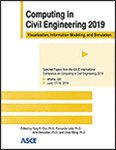ASCE International Conference on Computing in Civil Engineering 2019
Worksite Object Characterization for Automatically Updating Building Information Models
Publication: Computing in Civil Engineering 2019: Visualization, Information Modeling, and Simulation
ABSTRACT
Automated data capture systems could significantly improve the efficiency and productivity of the architecture, engineering, construction, and facility management (AEC/FM) industry. However, automatically collecting spatiotemporal information in an unstructured environment such as a construction site or a work place remains a time consuming and challenging task. This paper presents a new approach to automated data capture and processing, referred to as object characterization. In object characterization, the goal is to identify common objects in a scene and extract rich semantic information about those objects. A novel 2D-3D object detection algorithm is designed for detection and characterization of common worksite objects. The proposed system has applications in automated surveying and data collection, especially in applications which leverage unmanned aerial vehicles or mobile robots. To demonstrate this utility, the proposed system is deployed on a mobile robot and used to detect newly placed objects in a worksite environment.
Get full access to this article
View all available purchase options and get full access to this chapter.
Acknowledgement
This research is partially supported by the Center for Integrated Facility Engineering at Stanford University. The first author is also supported by the John A. Blume fellowship.
REFERENCES
Armeni, I., Sener, O., Zamir, A. R., Jiang, H., Brilakis, I., Fischer, M., and Savarese, S. (2016). “3D semantic parsing of large-scale indoor spaces.” IEEE Conference on Computer Vision and Pattern Recognition (CVPR), Las Vegas, NV, USA, 1534–1543.
Asadi, K., and Han, K. (2018). “Real-Time image-to-BIM registration using perspective alignment for automated construction monitoring.” Construction Research Congress.
Engelhard, N., Endres, F., Hess, J., Sturm, J., and Burgard, W. (2011). “Real-time 3D visual SLAM with a hand-held RGB-D camera.” Vasteras, Sweden, 1–15.
Feng, C., Liu, M.-Y., Kao, C.-C., and Lee, T.-Y. (2017). “Deep active learning for civil infrastructure defect detection and classification.” ASCE International Workshop on Computing in Civil Engineering, Seattle, WA, United States, 298–306.
Ferguson, M., and Law, K. (2019). “A 2D-3D Object Detection System for Updating Building Information Models with Mobile Robots.” IEEE Winter Conference on Applications of Computer Vision (WACV), Waikoloa Village, HI, USA.
Gao, Y., and Mosalam, K. M. (2018). “Deep transfer learning for image-based structural damage recognition.” Computer-Aided Civil and Infrastructure Engineering, 33(9), 748–768.
Glorot, X., and Bengio, Y. (2010). “Understanding the difficulty of training deep feedforward neural networks.” Thirteenth International Conference on Artificial Intelligence and Statistics (AISTATS), Sardinia, Italy, 249–256.
Goodfellow, I., Bengio, Y., Courville, A., and Bengio, Y. (2016). Deep Learning. MIT press Cambridge.
Hamledari, H., McCabe, B., and Davari, S. (2017a). “Automated computer vision-based detection of components of under-construction indoor partitions.” Automation in Construction, 74, 78–94.
Hamledari, H., Rezazadeh Azar, E., and McCabe, B. (2017b). “IFC-based development of as-built and as-is BIMs using construction and facility inspection data: Site-to-BIM data transfer automation.” Journal of Computing in Civil Engineering, 32(2).
He, K., Gkioxari, G., Dollár, P., and Girshick, R. (2017). “Mask R-CNN.” IEEE International Conference on Computer Vision (ICCV), IEEE, Venice, Italy, 2980–2988.
Kerl, C., Sturm, J., and Cremers, D. (2013). “Dense visual SLAM for RGB-D cameras.” IEEE/RSJ International Conference on Intelligent Robots and Systems (IROS), Tokyo Big Sight, Tokyo, Japan, 2100–2106.
Lin, T.-Y., Maire, M., Belongie, S., Hays, J., Perona, P., Ramanan, D., Dollár, P., and Zitnick, C. L. (2014). “Microsoft COCO: Common objects in context.” European Conference on Computer Vision (ECCV), Zurich, Switzerland, 740–755.
Manning, C., Raghavan, P., and Schütze, H. (2008). Introduction to Information Retrieval. Cambridge University Press.
McCabe, B., Hamledari, H., Shahi, A., Zangeneh, P., and Azar, E. R. (2017). “Roles, benefits, and challenges of using UAVs for indoor smart construction applications.” ASCE International Workshop on Computing in Civil Engineering, 349–357.
Park, J., Cho, Y. K., and Martinez, D. (2016). “A BIM and UWB integrated mobile robot navigation system for indoor position tracking applications.” Journal of Construction Engineering and Management, 6(2), 30–39.
Rusu, R. B., Marton, Z. C., Blodow, N., Dolha, M., and Beetz, M. (2008). “Towards 3D point cloud based object maps for household environments.” Robotics and Autonomous Systems, 56(11), 927–941.
Szegedy, C., Ioffe, S., Vanhoucke, V., and Alemi, A. A. (2017). “Inception-v4, inception-resnet and the impact of residual connections on learning.” Thirty-First AAAI Conference on Artificial Intelligence (AAAI), San Francisco, California, USA, 12.
Tchapmi, L. P., Choy, C. B., Armeni, I., Gwak, J., and Savarese, S. (2017). “SEGCloud: Semantic segmentation of 3D point clouds.” arXiv preprint arXiv:1710.07563.
Thrun, S., and Leonard, J. J. (2008). “Simultaneous localization and mapping.” Springer Handbook of Robotics, Springer, 871–889.
Zaidi, Q., and Bostic, M. (2008). “Color strategies for object identification.” Vision research, 48(26), 2673–2681.
Zhu, Z., Park, M.-W., Koch, C., Soltani, M., Hammad, A., and Davari, K. (2016). “Predicting movements of onsite workers and mobile equipment for enhancing construction site safety.” Automation in Construction, 68, 95–101.
Information & Authors
Information
Published In
Computing in Civil Engineering 2019: Visualization, Information Modeling, and Simulation
Pages: 303 - 311
Editors: Yong K. Cho, Ph.D., Georgia Institute of Technology, Fernanda Leite, Ph.D., University of Texas at Austin, Amir Behzadan, Ph.D., Texas A&M University, and Chao Wang, Ph.D., Louisiana State University
ISBN (Online): 978-0-7844-8242-1
Copyright
© 2019 American Society of Civil Engineers.
History
Published online: Jun 13, 2019
Authors
Metrics & Citations
Metrics
Citations
Download citation
If you have the appropriate software installed, you can download article citation data to the citation manager of your choice. Simply select your manager software from the list below and click Download.
